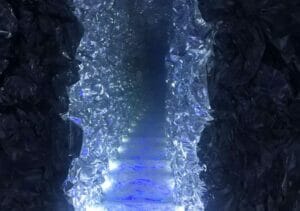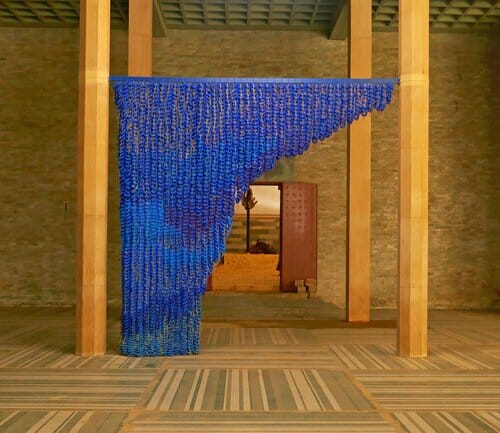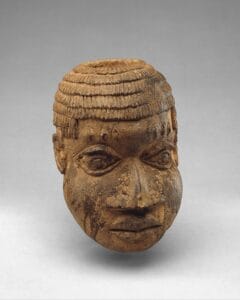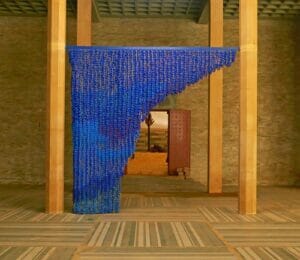The fourteenth edition of the Dakar Biennale, Dak’Art, last year further cemented the Senegalese biennale’s reputation as a platform for promoting emerging artists and as a meeting point for aficionados of African contemporary art.
Curated by El Hadji Malick Ndiaye and held from from 19 May – 21 June 2022, it had been planned to take place in 2020 but was postponed because of the Covid-19 pandemic.
Titled ‘Ĩ’Ndaffa # Forger/Out of the fire’, it was themed around the alchemical and risk-taking capacity of artists to transform materials and concepts in order to create new works with novel meanings.
Indeed, ‘Ĩ’Ndaffa’ is a word in the Serer language (spoken in parts of Senegal and Gambia) that means to forge. Its inclusion in the title alludes to the affirmation of forging identity linguistically.
“This ability to name things in African languages is the first step to change,” wrote Ndiaye wrote in the catalogue’s introduction where he explained his aim of reflecting upon the inter-relationships between art, activism and archives.
Since its founding in 1990, the government-supported Dak’Art – which initially focused on literature before shifting one edition later to visual art – has consistently striven to construct an identity as a point of convergence for artistic disciplines.
An event where to spot African artists
It has served as the launchpad for numerous artists from the African continent, ranging from the veteran Malian textile artist Abdoulaye Konaté to the Ethiopian photographer Aïda Muluneh. Embodying a pan-African vision, it also builds on the concept of négritude articulated by Léopold Senghor, the poet, writer and first president of Senegal following its independence from France.
Ndiaye’s selection of 59 artists and artist collectives, including 19 from the diaspora, to participate in the main exhibition (held in the former Palais de Justice) continued the biennale’s sense of vocation. Running concurrently, around 400 satellite events from exhibitions to visits of artists’ studios animated the city.
Senegal’s ministry of culture awarded its ‘Revelation’ prize to the French-Tunisian artist Férielle Doulain-Zouari for her eye-catching installation, ‘Current Water’ (2022), in deep hues of blue. Hung between two pillars and loosely evoking a waterfall, it was made by interweaving vernacular materials like plastic tubes, wire and rope using both industrial and artisanal methods.

Meanwhile, the Senegalese artist Caroline Gueye won the ECOWAS Integration prize from the Economic Community of West African States for the best contemporary creator from Western Africa. Having pursued her education in France, the US and China, Gueye applies knowledge gained from her degree in physics, radio protection and nuclear safety to create large-scale installations. On view was an arresting multi-media installation using thermoplastics that explored how diverse elements interact and provoked the visitor to consider the impact of physics on everyday life.
“This edition featured young, emerging artists taking audacious paths and trying out new things,” Hélène Tissières, an academic in African studies, says. “I’m convinced that Dak’Art has played a central role [in bringing visibility to African artists], despite some difficult years of economic hardship, because it has maintained a vision that is difficult to find elsewhere.”
While some projects resonated with the biennale’s “forging” theme in a literal way, others revisited archives to reinterpret aspects of history. A newspaper-press installation by Adji Dieye drew inspiration from the Italian and Senegalese artist’s personal archives and the National Archives of Senegal. ‘Culture Lost and Learned by Heart – part 2’ comprised a long white silk train printed with sepia-toned images and portraits that was draped over a wrought-iron structure. Some images were taken during the French colonial era, others during the nascent years of building national identity following independence, others more recently. This all culminated in a poignant piece about the country’s printed history.
South American diaspora is back to the roots
Elsewhere, Fluxos do Atlântico, a collective of 12 artists based in Salvador in Brazil’s Bahia region presented a video installation based on archives in Salvador’s Afro-Brazilian Museum and Casa do Benin. The work is part of the collective’s broader goal to rethink exchanges between Brazil and Africa from a decolonial perspective. https://fluxosdoatlanticosul.wordpress.com
Remembering the pioneers throughout music
The South African-born, Paris-based Mo Laudi – an artist, composer and DJ whose real name is Ntshepe Bopape – also exhibited archive-generated work. On display was his experimental sound piece ‘Motho ke motho ka batho (A Tribute to Mancoba)’. Initially commissioned for an exhibition dedicated to the South African avant-garde, modernist artist Ernest Mancoba at the Centre Pompidou in 2019, it blends extracts of Mancoba’s recorded voice with Zhosa throat singing and drum playing. Abstract collages accompanied the work.
Further highlights included Obinna Makata’s memorable installation, ‘Medicine after death’ (2019-2020). Meditating on how western countries might send both relief materials and guns to war-torn African countries, the Nigerian artist conceived a sculptural work centred on a gun fashioned from bones and syringes.
Besides the main exhibition, the myriad of satellite events was boosted by a beautiful show on Malian master Konaté. On view were mesmerising textile works portraying abstract landscapes made from hundreds of small, vertical, stitched ribbons. The exhibition brought an extra dose of gravitas to the biennale.
Asia and Africa art exchange
The sweeping programme also included Senegalese, Ivorian and Chinese pavilions (Ivory Coast and China being guest countries at this edition) and the exhibition Black Rock 40 on artists who have participated in Black Rock Senegal, the artists’ residency opened by Kehinde Wiley.




